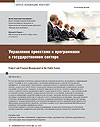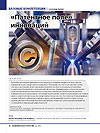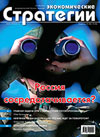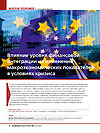Project and Program Management in the Public Sector
The article deals with the problem of improving management of projects and programs in the public sector. The role of public organizations in forming and developing this discipline of management is discussed. On the basis of published international research data the main reasons, that may hinder successful achievement of implementation purposes of the government projects and programs, are provided. The article describes the measures aimed, according to the US experts, at providing control of the costs rising and reduction of unnecessary tasks duplication in the public sector. Among them — centralization of efforts aimed at improving management of public projects and programs, involvement of their managers in planning and elaborating management solutions, promotion of the program manager’s professional prestige and specification of his career trajectory in government organizations, greater attention to training and formation of program managers, definition of requirements to certification of appropriate specialists, creating professional community of projects and programs managers within the government. The paper presents legislative initiatives, introduced in the US Congress in order to increase responsibility for programs management at the federal level. In the final part of the article some conclusions and recommendations are given, that may be useful in the national practice of managing government projects and programs, based on the accumulated international experience.







